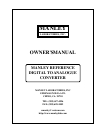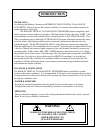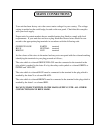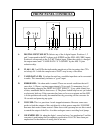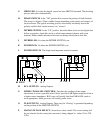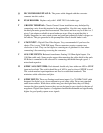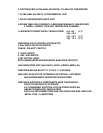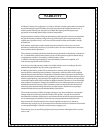Q IEC POWER RECEPTACLE: The power cable shipped with the converter
connects into this socket.
R FUSE HOLDER: Replace only with 1 AMP 220 Volt similar type.
T GROUND TERMINAL: Chassis Ground. Some installations may be helped by
connecting a wire from this terminal to the preamplifier. Also this may require that
the third pin mains ground be disconnected. The easiest and best way to do this is a 3
pin to 2 pin adapter available in most hardware stores. Keep in mind that this is
slightly dangerous in a mis-wired system and could put potentially lethal voltages on
the chassis. This pin grounded to the preamplifier chassis should make it safe.
U AT&T INPUT: Digital Glass Fiber Intputs. Very recommended if you have the
choice. This is not a TOSLINK input. These connectors require a quarter turn
clockwise to lock. They can be fragile so some degree of gentleness is best when
connecting / disconnecting or moving the converter.
V AES / EBU INPUTS: Balanced transformer floating 110 Ohm digital inputs. Use
110 Ohm cable only. Some people suggest disconnecting the cable shield at the male
XLR that is connected to the converter or connecting the shield through a good .1
microfarad capacitor.
W S/PDIF / AES SWITCHES: Each channel should only have either an AES or SPDIF
input and not both. The switch should be up if AES is used or down if SPDIF is used.
The switch matches input impedance and level to established standards. This
minimizes cable reflections and jitter.
X S/PDIF INPUTS: These are floating transformer inputs. Use 75 OHM COAX cable
designed for digital or as a lesser alternative good video cable. Do not use standard
audio interconnects. While these cables may pass the digital data, they will likely
increase the jitter quantity because they are not designed to pass signals in the tens of
megahertz. Digital data requires a 5 megahertz bandwidth minimum and significantly
higher for good quality square wave signals.



